Financial Analysis: Cost-Plus Technique and Ratio Formulation
VerifiedAdded on 2023/06/10
|8
|1334
|289
Report
AI Summary
This report delves into the intricacies of financial resource management, beginning with an exploration of the cost-plus technique and its impact on decision-making processes. It then proceeds to formulate and analyze various financial ratios derived from a profit and loss statement, providing insights into a company's financial performance and operational efficiency. The report further examines key financial terms, such as budgeting, favorable and unfavorable variances, and direct labor variance, providing individual examples to illustrate their practical application. The analysis includes calculations of the current ratio, quick ratio, and debt-equity ratio, offering a comprehensive overview of the company's financial standing. The report's conclusion underscores the importance of financial stability and efficiency in a competitive market, and it provides references to relevant sources used in the analysis.
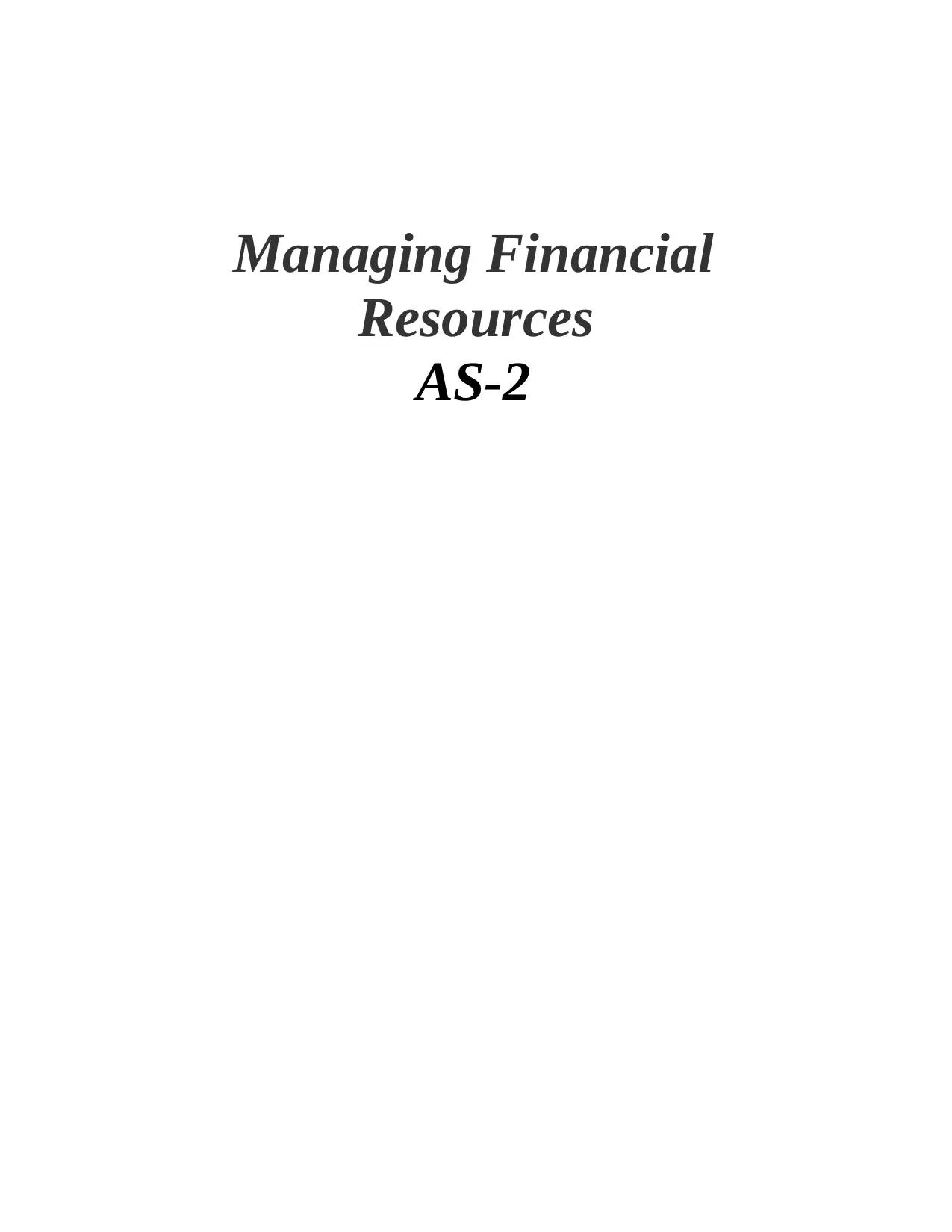
Managing Financial
Resources
AS-2
Resources
AS-2
Paraphrase This Document
Need a fresh take? Get an instant paraphrase of this document with our AI Paraphraser
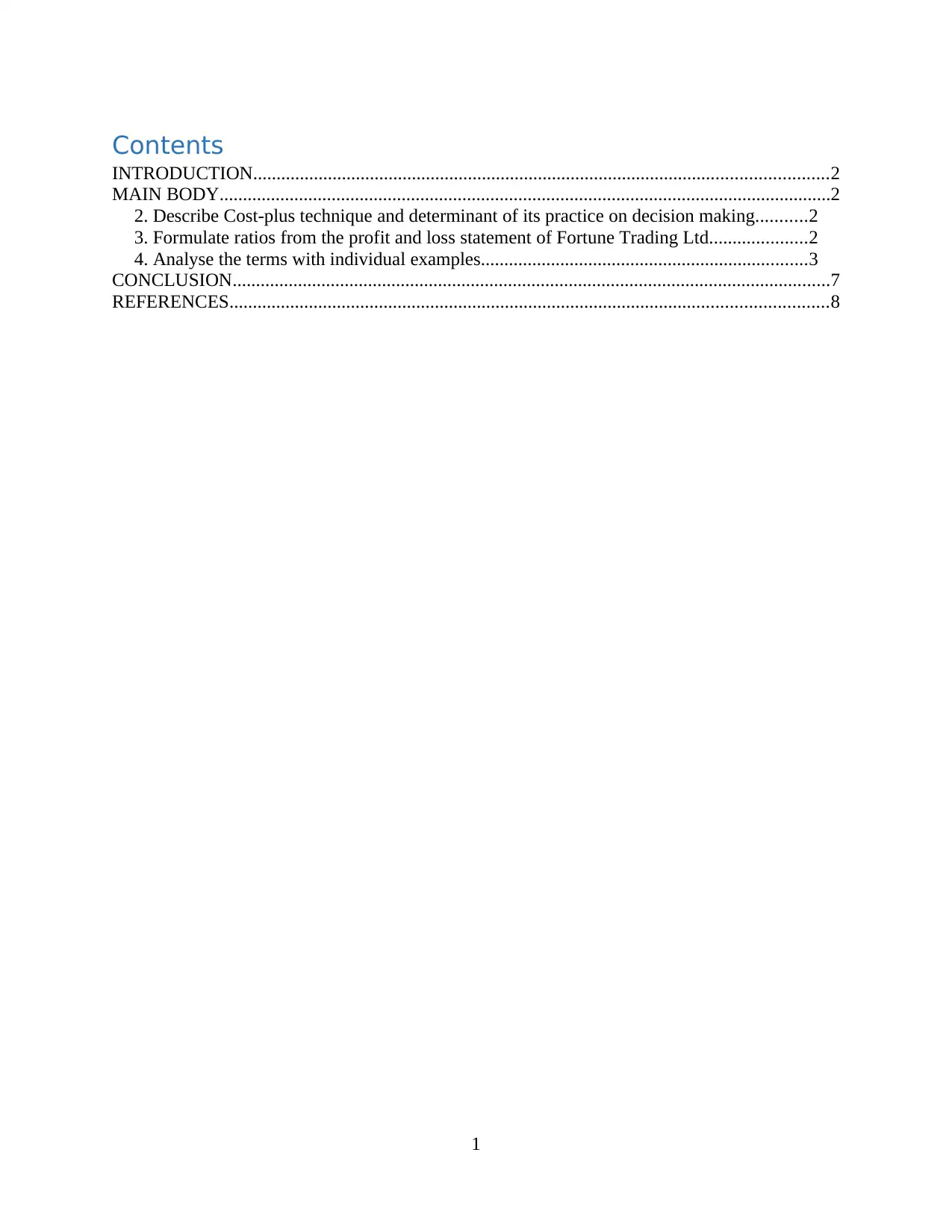
Contents
INTRODUCTION...........................................................................................................................2
MAIN BODY...................................................................................................................................2
2. Describe Cost-plus technique and determinant of its practice on decision making...........2
3. Formulate ratios from the profit and loss statement of Fortune Trading Ltd.....................2
4. Analyse the terms with individual examples......................................................................3
CONCLUSION................................................................................................................................7
REFERENCES................................................................................................................................8
1
INTRODUCTION...........................................................................................................................2
MAIN BODY...................................................................................................................................2
2. Describe Cost-plus technique and determinant of its practice on decision making...........2
3. Formulate ratios from the profit and loss statement of Fortune Trading Ltd.....................2
4. Analyse the terms with individual examples......................................................................3
CONCLUSION................................................................................................................................7
REFERENCES................................................................................................................................8
1
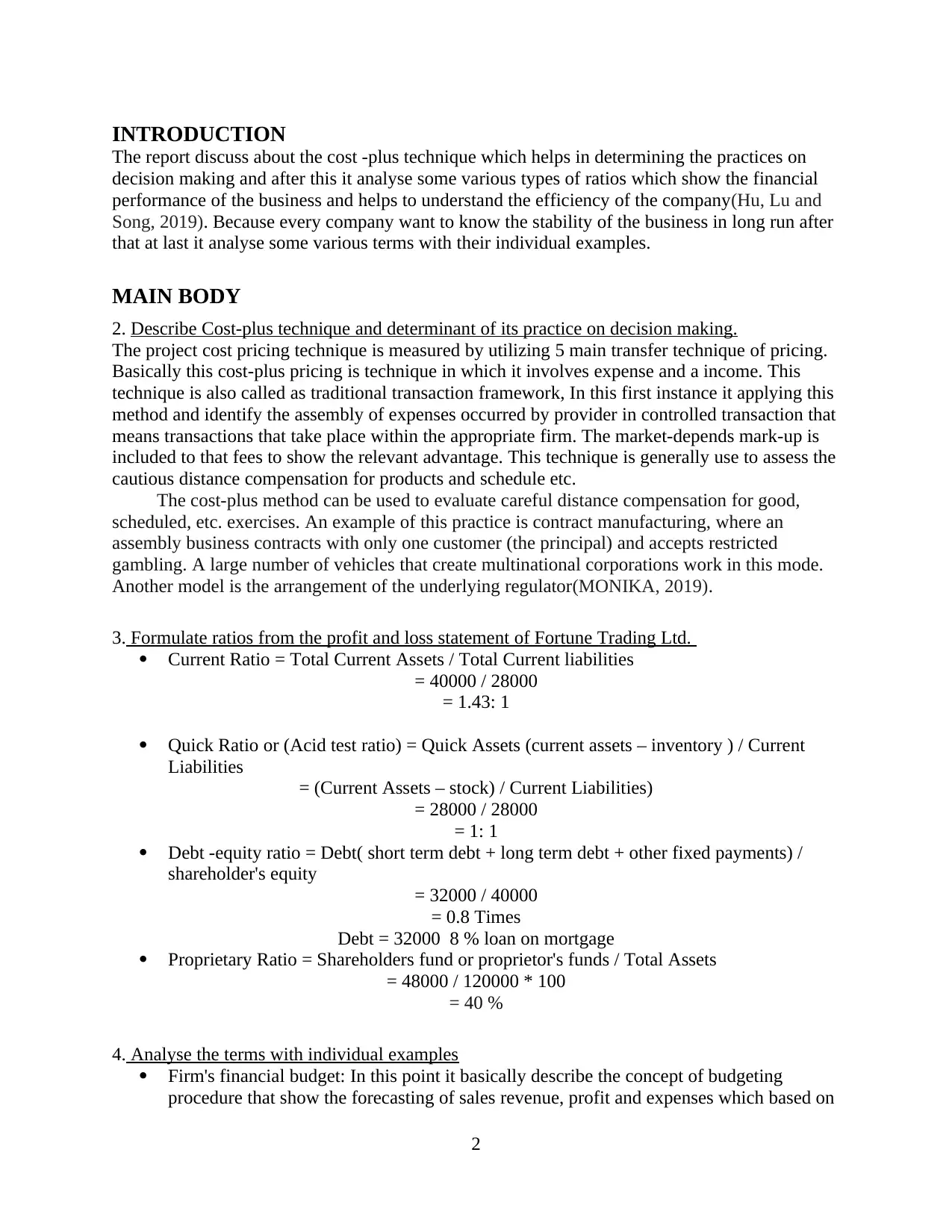
INTRODUCTION
The report discuss about the cost -plus technique which helps in determining the practices on
decision making and after this it analyse some various types of ratios which show the financial
performance of the business and helps to understand the efficiency of the company(Hu, Lu and
Song, 2019). Because every company want to know the stability of the business in long run after
that at last it analyse some various terms with their individual examples.
MAIN BODY
2. Describe Cost-plus technique and determinant of its practice on decision making.
The project cost pricing technique is measured by utilizing 5 main transfer technique of pricing.
Basically this cost-plus pricing is technique in which it involves expense and a income. This
technique is also called as traditional transaction framework, In this first instance it applying this
method and identify the assembly of expenses occurred by provider in controlled transaction that
means transactions that take place within the appropriate firm. The market-depends mark-up is
included to that fees to show the relevant advantage. This technique is generally use to assess the
cautious distance compensation for products and schedule etc.
The cost-plus method can be used to evaluate careful distance compensation for good,
scheduled, etc. exercises. An example of this practice is contract manufacturing, where an
assembly business contracts with only one customer (the principal) and accepts restricted
gambling. A large number of vehicles that create multinational corporations work in this mode.
Another model is the arrangement of the underlying regulator(MONIKA, 2019).
3. Formulate ratios from the profit and loss statement of Fortune Trading Ltd.
Current Ratio = Total Current Assets / Total Current liabilities
= 40000 / 28000
= 1.43: 1
Quick Ratio or (Acid test ratio) = Quick Assets (current assets – inventory ) / Current
Liabilities
= (Current Assets – stock) / Current Liabilities)
= 28000 / 28000
= 1: 1
Debt -equity ratio = Debt( short term debt + long term debt + other fixed payments) /
shareholder's equity
= 32000 / 40000
= 0.8 Times
Debt = 32000 8 % loan on mortgage
Proprietary Ratio = Shareholders fund or proprietor's funds / Total Assets
= 48000 / 120000 * 100
= 40 %
4. Analyse the terms with individual examples
Firm's financial budget: In this point it basically describe the concept of budgeting
procedure that show the forecasting of sales revenue, profit and expenses which based on
2
The report discuss about the cost -plus technique which helps in determining the practices on
decision making and after this it analyse some various types of ratios which show the financial
performance of the business and helps to understand the efficiency of the company(Hu, Lu and
Song, 2019). Because every company want to know the stability of the business in long run after
that at last it analyse some various terms with their individual examples.
MAIN BODY
2. Describe Cost-plus technique and determinant of its practice on decision making.
The project cost pricing technique is measured by utilizing 5 main transfer technique of pricing.
Basically this cost-plus pricing is technique in which it involves expense and a income. This
technique is also called as traditional transaction framework, In this first instance it applying this
method and identify the assembly of expenses occurred by provider in controlled transaction that
means transactions that take place within the appropriate firm. The market-depends mark-up is
included to that fees to show the relevant advantage. This technique is generally use to assess the
cautious distance compensation for products and schedule etc.
The cost-plus method can be used to evaluate careful distance compensation for good,
scheduled, etc. exercises. An example of this practice is contract manufacturing, where an
assembly business contracts with only one customer (the principal) and accepts restricted
gambling. A large number of vehicles that create multinational corporations work in this mode.
Another model is the arrangement of the underlying regulator(MONIKA, 2019).
3. Formulate ratios from the profit and loss statement of Fortune Trading Ltd.
Current Ratio = Total Current Assets / Total Current liabilities
= 40000 / 28000
= 1.43: 1
Quick Ratio or (Acid test ratio) = Quick Assets (current assets – inventory ) / Current
Liabilities
= (Current Assets – stock) / Current Liabilities)
= 28000 / 28000
= 1: 1
Debt -equity ratio = Debt( short term debt + long term debt + other fixed payments) /
shareholder's equity
= 32000 / 40000
= 0.8 Times
Debt = 32000 8 % loan on mortgage
Proprietary Ratio = Shareholders fund or proprietor's funds / Total Assets
= 48000 / 120000 * 100
= 40 %
4. Analyse the terms with individual examples
Firm's financial budget: In this point it basically describe the concept of budgeting
procedure that show the forecasting of sales revenue, profit and expenses which based on
2
⊘ This is a preview!⊘
Do you want full access?
Subscribe today to unlock all pages.

Trusted by 1+ million students worldwide
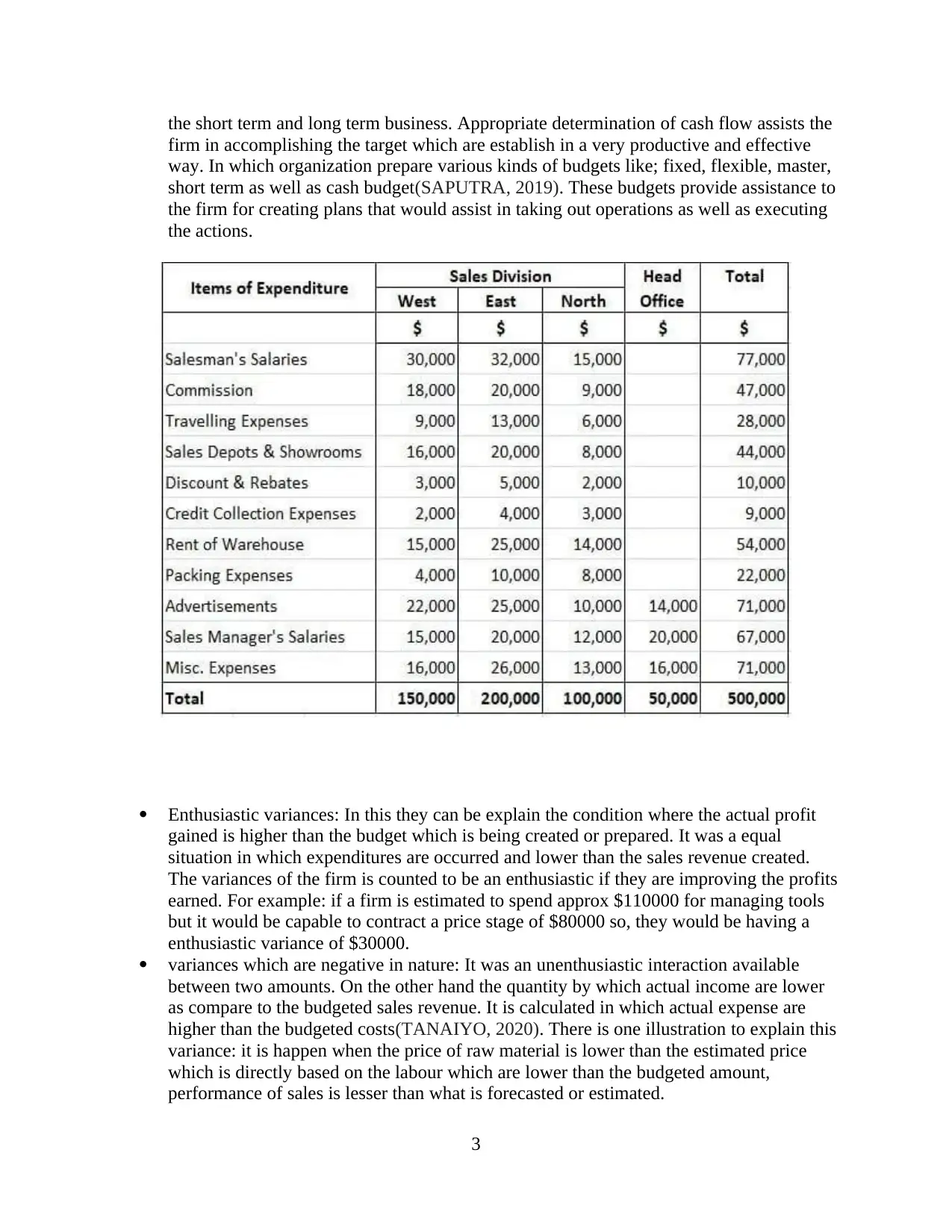
the short term and long term business. Appropriate determination of cash flow assists the
firm in accomplishing the target which are establish in a very productive and effective
way. In which organization prepare various kinds of budgets like; fixed, flexible, master,
short term as well as cash budget(SAPUTRA, 2019). These budgets provide assistance to
the firm for creating plans that would assist in taking out operations as well as executing
the actions.
Enthusiastic variances: In this they can be explain the condition where the actual profit
gained is higher than the budget which is being created or prepared. It was a equal
situation in which expenditures are occurred and lower than the sales revenue created.
The variances of the firm is counted to be an enthusiastic if they are improving the profits
earned. For example: if a firm is estimated to spend approx $110000 for managing tools
but it would be capable to contract a price stage of $80000 so, they would be having a
enthusiastic variance of $30000.
variances which are negative in nature: It was an unenthusiastic interaction available
between two amounts. On the other hand the quantity by which actual income are lower
as compare to the budgeted sales revenue. It is calculated in which actual expense are
higher than the budgeted costs(TANAIYO, 2020). There is one illustration to explain this
variance: it is happen when the price of raw material is lower than the estimated price
which is directly based on the labour which are lower than the budgeted amount,
performance of sales is lesser than what is forecasted or estimated.
3
firm in accomplishing the target which are establish in a very productive and effective
way. In which organization prepare various kinds of budgets like; fixed, flexible, master,
short term as well as cash budget(SAPUTRA, 2019). These budgets provide assistance to
the firm for creating plans that would assist in taking out operations as well as executing
the actions.
Enthusiastic variances: In this they can be explain the condition where the actual profit
gained is higher than the budget which is being created or prepared. It was a equal
situation in which expenditures are occurred and lower than the sales revenue created.
The variances of the firm is counted to be an enthusiastic if they are improving the profits
earned. For example: if a firm is estimated to spend approx $110000 for managing tools
but it would be capable to contract a price stage of $80000 so, they would be having a
enthusiastic variance of $30000.
variances which are negative in nature: It was an unenthusiastic interaction available
between two amounts. On the other hand the quantity by which actual income are lower
as compare to the budgeted sales revenue. It is calculated in which actual expense are
higher than the budgeted costs(TANAIYO, 2020). There is one illustration to explain this
variance: it is happen when the price of raw material is lower than the estimated price
which is directly based on the labour which are lower than the budgeted amount,
performance of sales is lesser than what is forecasted or estimated.
3
Paraphrase This Document
Need a fresh take? Get an instant paraphrase of this document with our AI Paraphraser
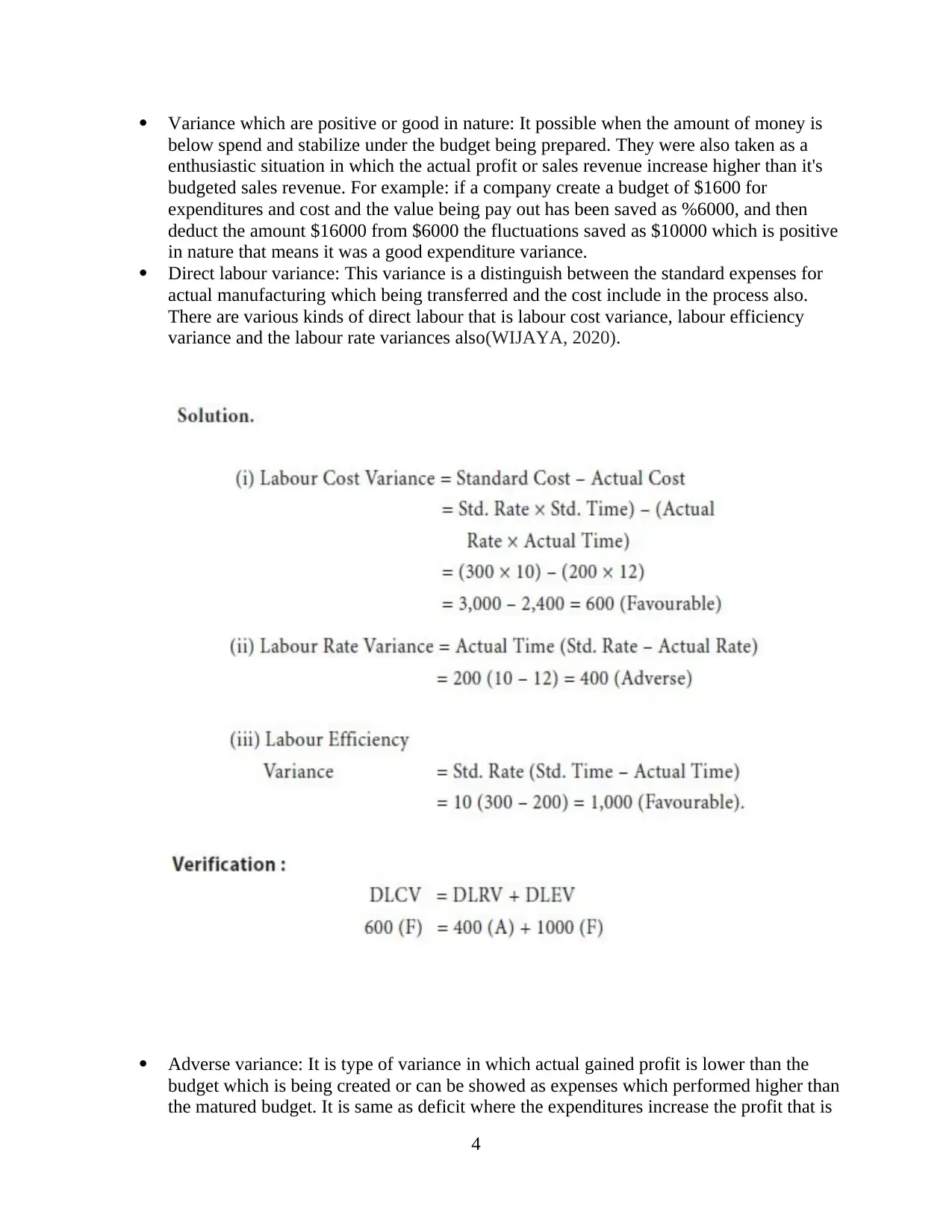
Variance which are positive or good in nature: It possible when the amount of money is
below spend and stabilize under the budget being prepared. They were also taken as a
enthusiastic situation in which the actual profit or sales revenue increase higher than it's
budgeted sales revenue. For example: if a company create a budget of $1600 for
expenditures and cost and the value being pay out has been saved as %6000, and then
deduct the amount $16000 from $6000 the fluctuations saved as $10000 which is positive
in nature that means it was a good expenditure variance.
Direct labour variance: This variance is a distinguish between the standard expenses for
actual manufacturing which being transferred and the cost include in the process also.
There are various kinds of direct labour that is labour cost variance, labour efficiency
variance and the labour rate variances also(WIJAYA, 2020).
Adverse variance: It is type of variance in which actual gained profit is lower than the
budget which is being created or can be showed as expenses which performed higher than
the matured budget. It is same as deficit where the expenditures increase the profit that is
4
below spend and stabilize under the budget being prepared. They were also taken as a
enthusiastic situation in which the actual profit or sales revenue increase higher than it's
budgeted sales revenue. For example: if a company create a budget of $1600 for
expenditures and cost and the value being pay out has been saved as %6000, and then
deduct the amount $16000 from $6000 the fluctuations saved as $10000 which is positive
in nature that means it was a good expenditure variance.
Direct labour variance: This variance is a distinguish between the standard expenses for
actual manufacturing which being transferred and the cost include in the process also.
There are various kinds of direct labour that is labour cost variance, labour efficiency
variance and the labour rate variances also(WIJAYA, 2020).
Adverse variance: It is type of variance in which actual gained profit is lower than the
budget which is being created or can be showed as expenses which performed higher than
the matured budget. It is same as deficit where the expenditures increase the profit that is
4
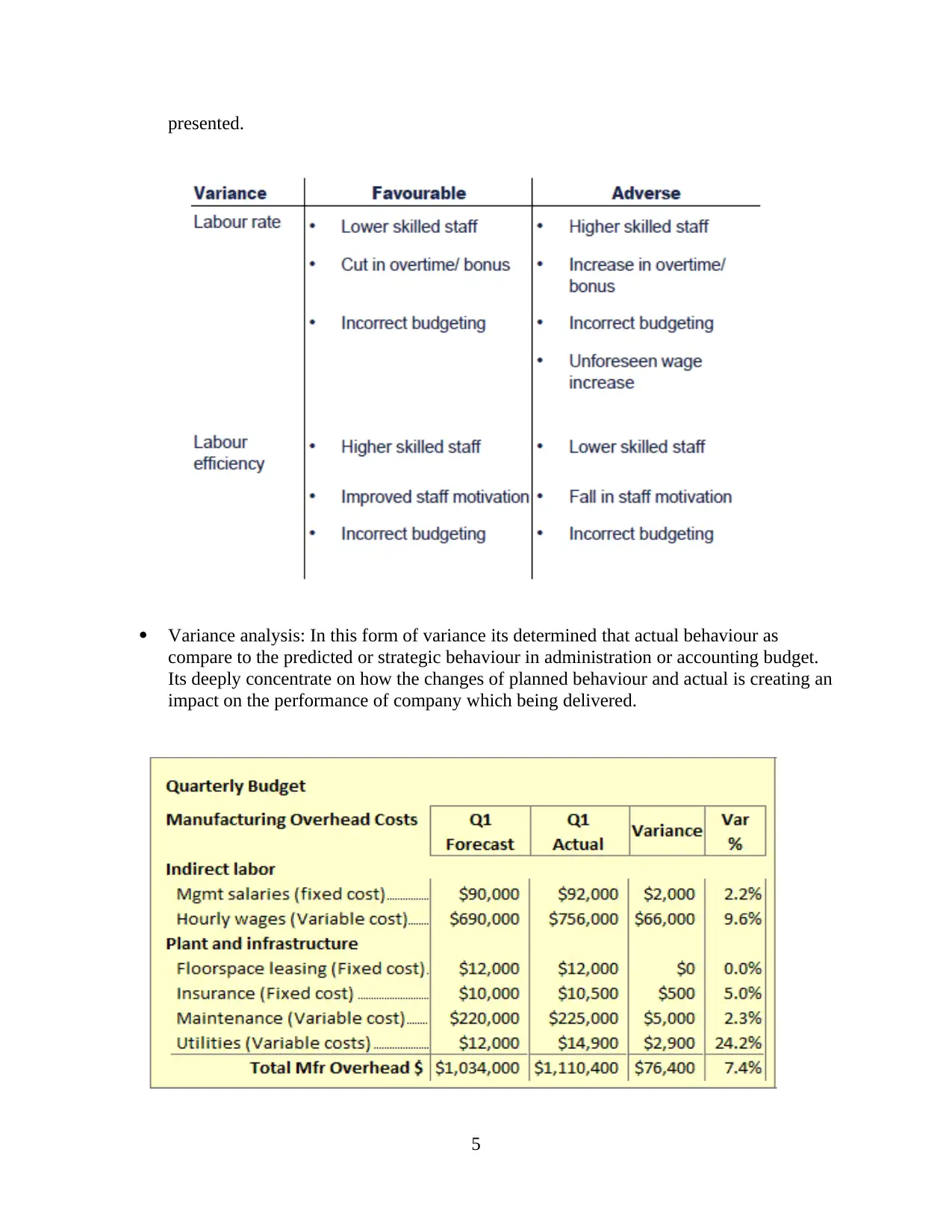
presented.
Variance analysis: In this form of variance its determined that actual behaviour as
compare to the predicted or strategic behaviour in administration or accounting budget.
Its deeply concentrate on how the changes of planned behaviour and actual is creating an
impact on the performance of company which being delivered.
5
Variance analysis: In this form of variance its determined that actual behaviour as
compare to the predicted or strategic behaviour in administration or accounting budget.
Its deeply concentrate on how the changes of planned behaviour and actual is creating an
impact on the performance of company which being delivered.
5
⊘ This is a preview!⊘
Do you want full access?
Subscribe today to unlock all pages.

Trusted by 1+ million students worldwide
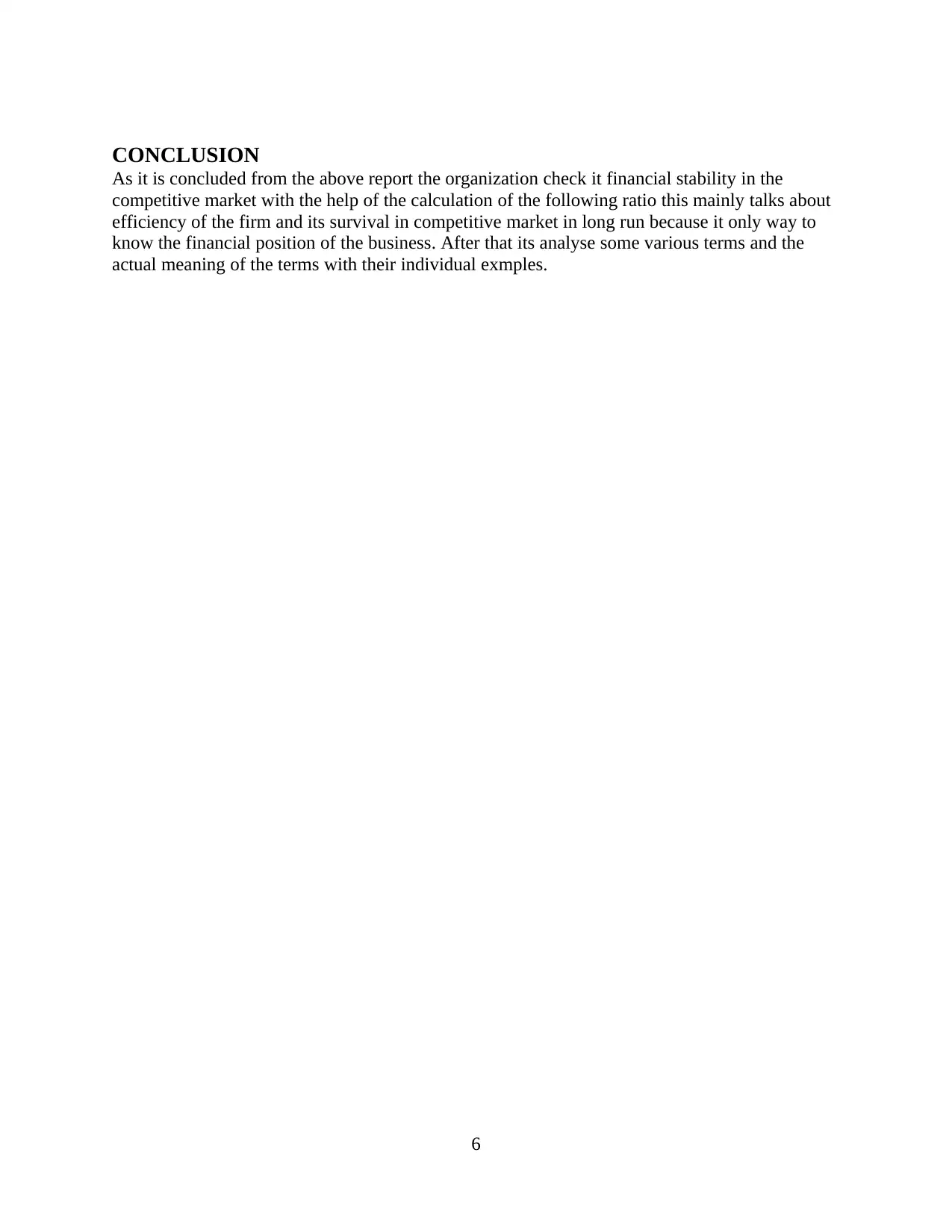
CONCLUSION
As it is concluded from the above report the organization check it financial stability in the
competitive market with the help of the calculation of the following ratio this mainly talks about
efficiency of the firm and its survival in competitive market in long run because it only way to
know the financial position of the business. After that its analyse some various terms and the
actual meaning of the terms with their individual exmples.
6
As it is concluded from the above report the organization check it financial stability in the
competitive market with the help of the calculation of the following ratio this mainly talks about
efficiency of the firm and its survival in competitive market in long run because it only way to
know the financial position of the business. After that its analyse some various terms and the
actual meaning of the terms with their individual exmples.
6
Paraphrase This Document
Need a fresh take? Get an instant paraphrase of this document with our AI Paraphraser
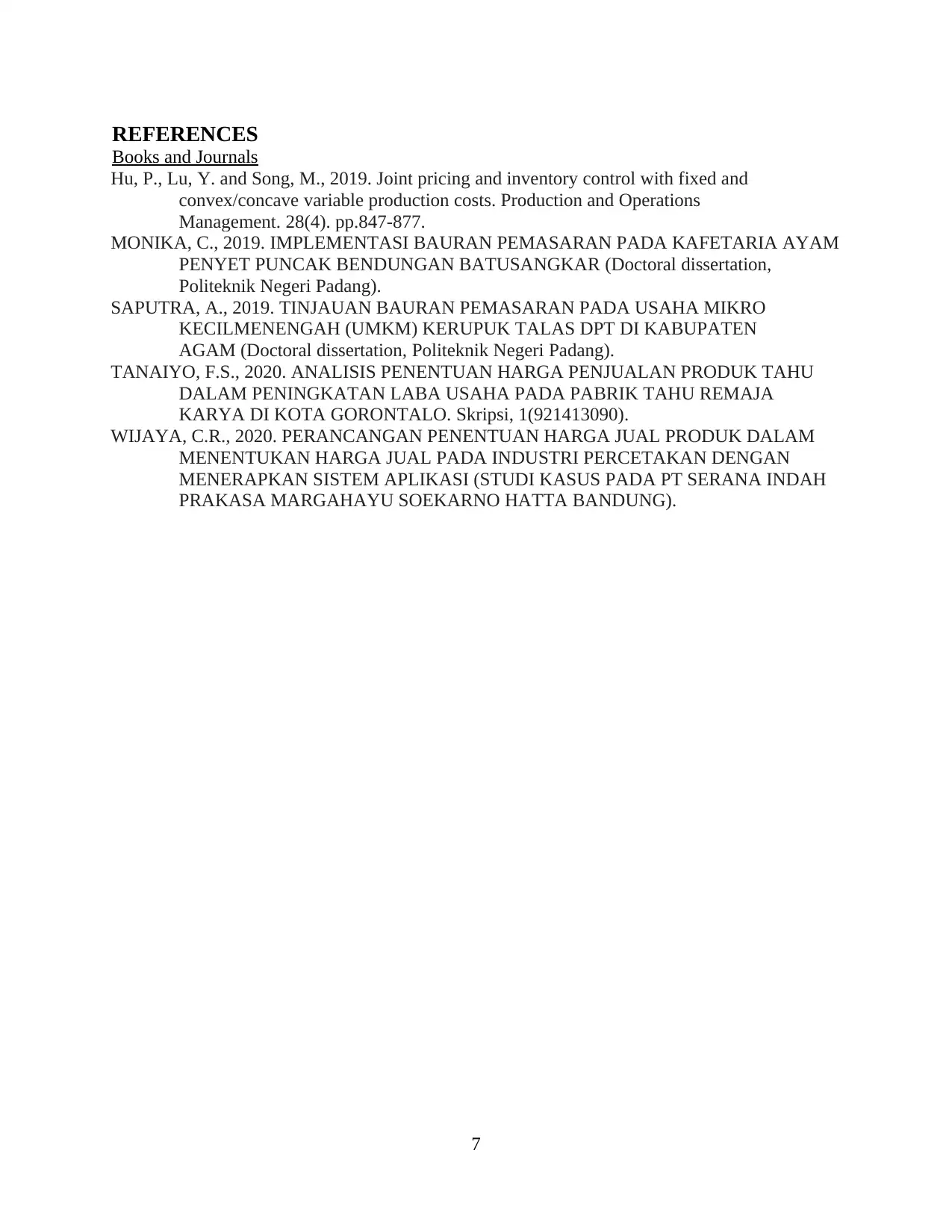
REFERENCES
Books and Journals
Hu, P., Lu, Y. and Song, M., 2019. Joint pricing and inventory control with fixed and
convex/concave variable production costs. Production and Operations
Management. 28(4). pp.847-877.
MONIKA, C., 2019. IMPLEMENTASI BAURAN PEMASARAN PADA KAFETARIA AYAM
PENYET PUNCAK BENDUNGAN BATUSANGKAR (Doctoral dissertation,
Politeknik Negeri Padang).
SAPUTRA, A., 2019. TINJAUAN BAURAN PEMASARAN PADA USAHA MIKRO
KECILMENENGAH (UMKM) KERUPUK TALAS DPT DI KABUPATEN
AGAM (Doctoral dissertation, Politeknik Negeri Padang).
TANAIYO, F.S., 2020. ANALISIS PENENTUAN HARGA PENJUALAN PRODUK TAHU
DALAM PENINGKATAN LABA USAHA PADA PABRIK TAHU REMAJA
KARYA DI KOTA GORONTALO. Skripsi, 1(921413090).
WIJAYA, C.R., 2020. PERANCANGAN PENENTUAN HARGA JUAL PRODUK DALAM
MENENTUKAN HARGA JUAL PADA INDUSTRI PERCETAKAN DENGAN
MENERAPKAN SISTEM APLIKASI (STUDI KASUS PADA PT SERANA INDAH
PRAKASA MARGAHAYU SOEKARNO HATTA BANDUNG).
7
Books and Journals
Hu, P., Lu, Y. and Song, M., 2019. Joint pricing and inventory control with fixed and
convex/concave variable production costs. Production and Operations
Management. 28(4). pp.847-877.
MONIKA, C., 2019. IMPLEMENTASI BAURAN PEMASARAN PADA KAFETARIA AYAM
PENYET PUNCAK BENDUNGAN BATUSANGKAR (Doctoral dissertation,
Politeknik Negeri Padang).
SAPUTRA, A., 2019. TINJAUAN BAURAN PEMASARAN PADA USAHA MIKRO
KECILMENENGAH (UMKM) KERUPUK TALAS DPT DI KABUPATEN
AGAM (Doctoral dissertation, Politeknik Negeri Padang).
TANAIYO, F.S., 2020. ANALISIS PENENTUAN HARGA PENJUALAN PRODUK TAHU
DALAM PENINGKATAN LABA USAHA PADA PABRIK TAHU REMAJA
KARYA DI KOTA GORONTALO. Skripsi, 1(921413090).
WIJAYA, C.R., 2020. PERANCANGAN PENENTUAN HARGA JUAL PRODUK DALAM
MENENTUKAN HARGA JUAL PADA INDUSTRI PERCETAKAN DENGAN
MENERAPKAN SISTEM APLIKASI (STUDI KASUS PADA PT SERANA INDAH
PRAKASA MARGAHAYU SOEKARNO HATTA BANDUNG).
7
1 out of 8
Related Documents
Your All-in-One AI-Powered Toolkit for Academic Success.
+13062052269
info@desklib.com
Available 24*7 on WhatsApp / Email
![[object Object]](/_next/static/media/star-bottom.7253800d.svg)
Unlock your academic potential
Copyright © 2020–2025 A2Z Services. All Rights Reserved. Developed and managed by ZUCOL.





